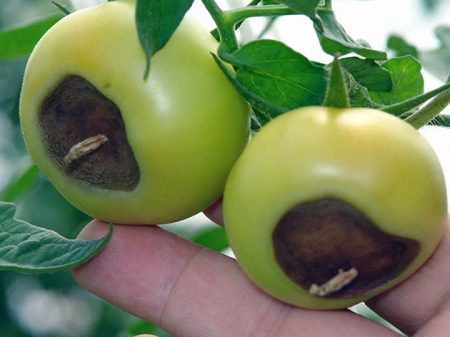
Blackening of fruits is a common problem of summer residents. Instead of gathering a rich harvest, they have to get rid of dead vegetables. Rotting fruits does not occur for no reason. And this means that every gardener is able to avoid a similar problem.
Content
- 1 Why do tomatoes rot on a bush
- 2 Why do green tomatoes turn black
- 3 Why do tomatoes turn green in a greenhouse?
- 4 Signs of tomato blackening
- 5 How to save a crop - how to treat
- 6 How to prevent the spread of the disease - prevention
- 7 Varieties of tomatoes resistant to fungal diseases
- 8 Tips, Secrets
- 9 Reviews
- 10 Conclusion
Why do tomatoes rot on a bush
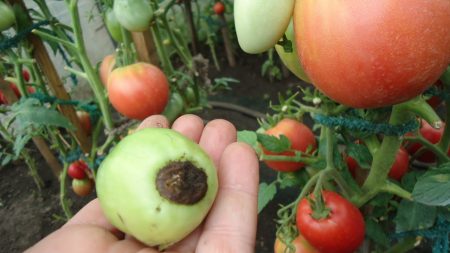
There are many causes of tomato disease. And in order to avoid a recurrence of an unpleasant situation, you need to understand what you are dealing with:
- gray rot. Otherwise, it is called ashes. It occurs due to infection with a fungal disease;
- late blight. It is caused by the spread of the fungus on the vegetable. A characteristic feature of late blight is brown spots;
- dry soil. Uneven watering can also cause rotting of the fruit;
- vertex rot. The disease is caused by too hot air in the greenhouse. The plant has nowhere to be fed with moisture, so it eats liquid from the fruit, which leads to the death of tomato cells;
- brown or dry spotting. The disease is called alternariosis. It is caused by a parasite fungus;
- stem necrosis is caused by viruses. It is characterized by the appearance of cracks on the lower part of the stem;
- lack of care. Inadequate care refers to a lack of fertilizer and sparse watering.
Why do green tomatoes turn black
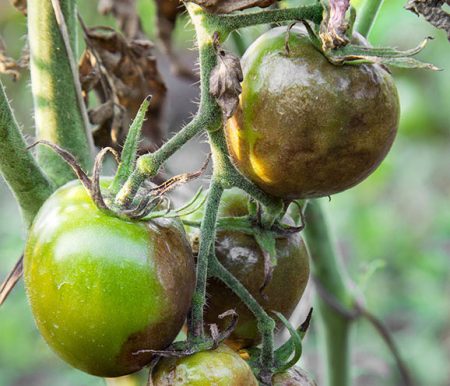
The blackening of green tomatoes is not such a large-scale problem as the decay of ripened fruits. In the first case, the correct definition of the disease and the rapid adoption of measures will save the whole crop.
As a rule, the causes of blackening of the still green fruit are a lack of moisture, various pests, improper fertilizer of the soil or ordinary plant rot. More accurately establish the cause of rotting of the fetus will allow visual and tactile inspection.
Vertex rot
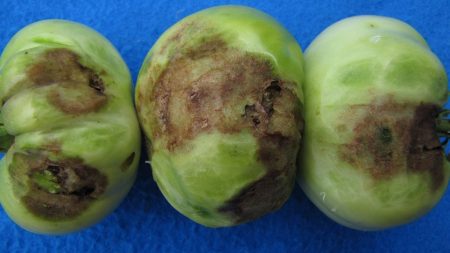
With this disease, indented spots appear on the tops of the fruits. First, they acquire a green tint, and then change it to taupe or even green. The infected plant stops its growth, and small cracks begin to appear on the affected area.
Wrong fertilizer
The result of improper fertilizer can be either an excess of salt in the soil, or a deficiency of calcium. The fact that the plant receives the wrong nutrients that it needs, will signal the blackening of the fruit.
Lack of moisture
Black spots form on the surface of the tomato even when the plant lacks moisture. When a vegetable has nothing to eat, it begins to take moisture from the air. You will be able to understand that the whole point is in insufficient watering if you find that the roots of tomatoes have come out over the soil.
Late blight
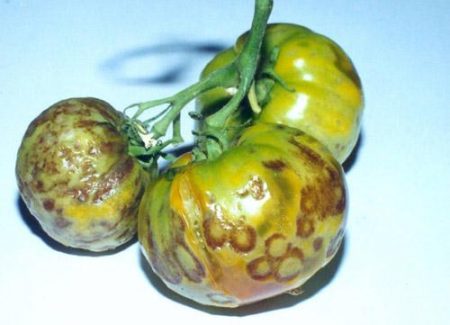
Such a disease, on the contrary, causes an excess of moisture. High humidity or temperature jumps contribute to the propagation of the fungal bacterium, which causes the appearance of dark spots on the surface of the fruit.
Why do tomatoes turn green in a greenhouse?
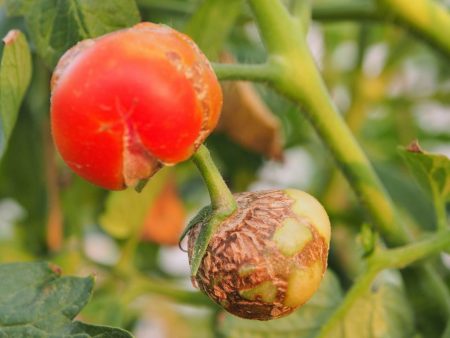
Blackening of tomatoes in greenhouses also occurs due to the development of various diseases. And, strangely enough, the cause of the disease is the same as that of green fruits: temperature jumps, violation of the temperature regime, increased humidity in the greenhouse.
But there are also such cases when already mature plants begin to rot.The reason for this is anthracnose. The disease begins with the appearance on the tomatoes of small dots that are very similar in color to the main color. But very soon, the dots will begin to darken, and blackness will spread throughout the fetus.
It will no longer be possible to save the infected crop. It is forbidden to eat it fresh, use it for cooking, and also take seeds from it.
Signs of tomato blackening
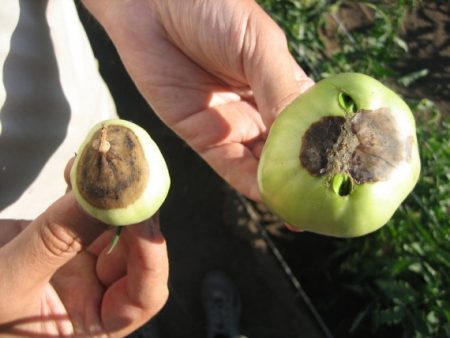
The signs of tomato blackening are independent of their sources. A disease always starts the same way. What is worth paying attention to summer residents:
- the appearance of small black spots on the fetus,
- black spots are soft to the touch,
- spots have already affected most of the fetus,
- blackening has a light gun coating,
- an unpleasant odor emanates from the affected areas.
The appearance of the above signs can indicate only one thing - a viral or fungal disease develops on the plant.
Blackening can often be seen on leaves and stems of tomatoes.
How to save a crop - how to treat
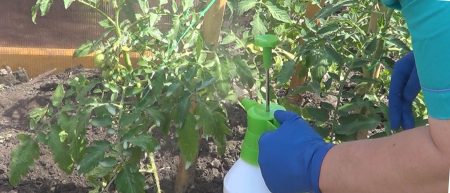
The treatment of a plant will depend on what it is infected with.
| Blackening reason | Plant treatment |
| Gray rot | Treatment begins with the removal of infected fruit. This should be done in sunny weather. After which the plant is sprayed with fungicides. If the tomatoes are not infected very much, a liquid like Topaz or Champion will do. If the damage is large-scale, the use of Fundazole, Scor, Ordan and others is recommended. |
| Late blight | As a medicine, Hom, Furacilin, Fitosporin, Trichopolum and Ordan are widely used. |
| Dry soil | Dry soil is treated with sufficient elemental watering. |
| Vertex rot | The remedies for the disease are Phytosporin and Bordeaux fluid. The latter is prepared as follows: mix 0.1 kg of quicklime with 1 liter of water, also dissolve in 9 liters of water and 0.1 kg of copper sulfate. Mix both solutions. |
| Brown or dry spotting | If the disease has already manifested, the following remedies will help: Antracol, Ditan, Flint, Infinity, Quadris, Ridomil. Processing must be carried out at least once every 2 weeks. |
| Stem Necrosis | It will not be possible to save the infected bushes, so they must be removed and burned. And the soil will need to be treated with Fitolavin. |
| Lack of care | In order to make the treatment right, it is only necessary to regularly nourish the soil of the plant, as well as properly fertilize it. |
How to prevent the spread of the disease - prevention
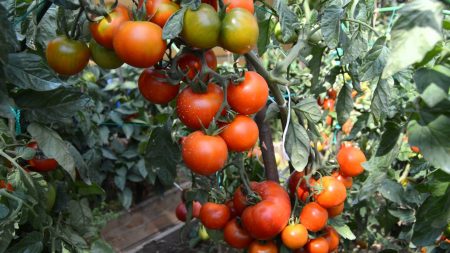
It is much easier to prevent the disease than to cure an already infected plant. Consider a few common ways.
Folk remedies
- Mix 10 liters of water and 300 grams of garlic, leave to brew for a day. Then spray the resulting mixture of ridges with the plant.
- Lactic acid bacteria do not allow the fungus to multiply and infect the fruit. Dilute 100 g of lactic acid product in 1 liter of water. Spray the mixture onto ridges.
- Dissolve about 1 cup of rock salt in 5 l of water. With this mixture, spray the tomatoes until the fruits fully ripen.
Watering
Watering piles is necessary at a time when the sun has not yet gained its activity. Usually, it is recommended to do this early in the morning or in the evening.
Watering is carried out strictly under the roots of the plant.
Stepson
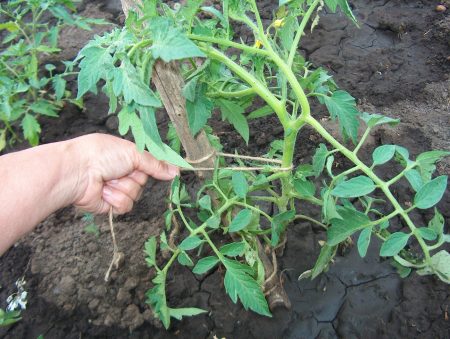
To accelerate the growth of fruits, as well as to avoid the death of the plant allow herding. Be sure to get rid of stepsons and lower leaves of tomatoes.
Crop rotation
Watch the crop rotation. If something from the nightshade family has already grown on the ridge, it is strictly not recommended to plant plants for 3-4 years.
Landing place
Choose a ventilated place to land. The soil for tomatoes should be slightly acidic, with a low nitrogen content. It is also advisable to take into account the dryness of the earth and its warmth.
Varieties of tomatoes resistant to fungal diseases
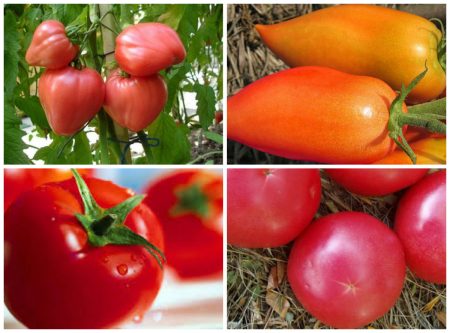
Even following all the recommendations will not give a 100% guarantee that the plant will avoid diseases. Therefore, we recommend that you choose those seeds that are resistant to the appearance of fungal diseases. Among them:
- early ripe varieties: Gnome, Chimgan, Orange Miracle, Oak;
- special varieties: Stolypin, Primadonna, Sovereign, Black cluster.
Tips, Secrets
There are some tips that will greatly facilitate the life of summer residents and help them avoid the defeat of tomatoes. Here are some of them:
- Before starting to germinate the seeds, warm them in the oven for just a few minutes.
- Complex fertilizers will help increase the plant's immunity.
- Leave a distance between the bushes. The optimal gap is 30 cm. If the disease affects one of the bushes, the virus or fungus does not have time to spread to a neighboring plant.
- Pierce the base of the seedling through copper wire.
- After each watering, be sure to spud each bush.
Reviews
Rimma
For a long time I suffered from the fact that tomatoes constantly blackened and decayed. I could not understand what the problem was. As it turned out, the whole thing was that the plant was hot. The region had a very high temperature. In addition, I could not timely water the bushes.
Evgeniy
Dark spots on the fruits also began to appear. As it turned out, it's all about fertilizer. Fed with calcium - the problem was solved.
Conclusion
Proper care of the site, the correct selection of fertilizers, watering on a schedule - this is not a whim of summer residents. Compliance with each of the recommendations and planting of special varieties will surely provide a rich harvest of tomatoes.




 Low-growing tomatoes, without pinching: 5 of the most delicious varieties
Low-growing tomatoes, without pinching: 5 of the most delicious varieties Why tomato seedlings grow poorly
Why tomato seedlings grow poorly We grow a tomato in a shell
We grow a tomato in a shell Growing tomatoes without watering according to the method of Kazarin
Growing tomatoes without watering according to the method of Kazarin